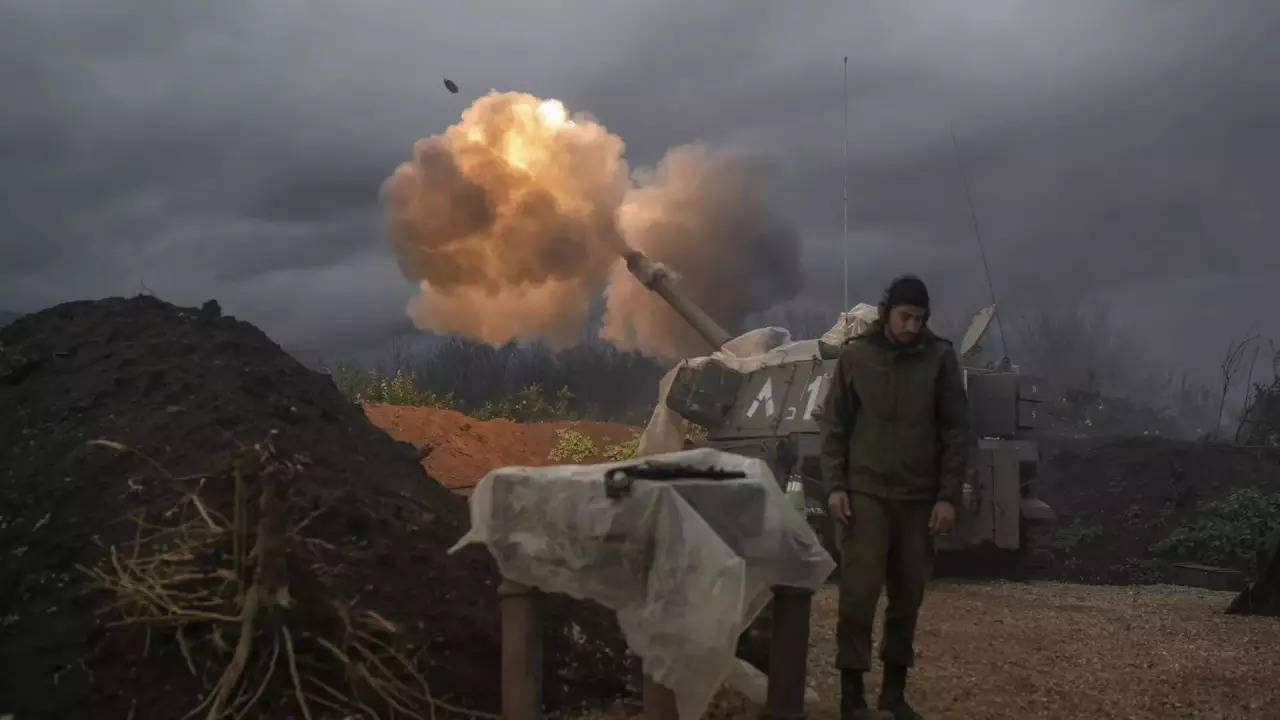RAFAH: The Israeli military seized control of the Rafah border crossing between the Gaza Strip and Egypt on Tuesday and its tanks pushed into the southern Gazan town of Rafah after a night of air strikes on the Palestinian enclave.
The Israeli offensive took place as mediators struggled to secure a ceasefire agreement between Israel and its Hamas foes and as the conflict entered its 8th month.
The Palestinian militant group said late on Monday it had agreed to a ceasefire proposal but Israel said the terms did not meet its demands.
Amid international concern over the plight of civilians crammed into Rafah, Israeli tanks and planes attacked several areas and houses there overnight. The Gaza health ministry said Israeli strikes across the enclave had killed 54 Palestinians and wounded 96 others in the past 24 hours.
More than one million people have sought refuge in Rafah, living in tented camps and makeshift shelters. Many are trying to leave, heeding Israeli orders for them to evacuate, but with large areas of the coastal enclave already laid to waste, they say they have nowhere safe to go to.
The Israeli military said a limited operation in Rafah was meant to kill fighters and dismantle infrastructure used by Hamas, which governs the besieged Palestinian territory.
The European Union’s foreign policy chief, Josep Borrell, speaking in Brussels on Tuesday, said the assault on Rafah would be deadly for civilians.
“The Rafah offensive has started again, in spite all the requests of the international community, the U.S., the European Union member states, everybody asking (Israeli Prime Minister Benjamin) Netanyahu not to attack,” Borrell told reporters.
“I am afraid that this is going to cause again a lot of casualties, civilian casualties. he said. “There are no safe zones in Gaza.”
Israel has for weeks threatened to mount a major incursion in Rafah, which it says harbours thousands of Hamas fighters and where potentially dozens of hostages are being held. Victory over Hamas is impossible without taking Rafah, it says.
A total of 34,789 Palestinians, most of then civilians, have been now killed in the conflict, the Gaza Health Ministry said in its daily update.
The war began when Hamas militants attacked Israel on Oct. 7, killing about 1,200 people and abducting about 250 others, of whom 133 are believed to remain in captivity in Gaza, according to Israeli tallies.
Rafah crossing closed
A Gaza border authority spokesperson told Reuters the Rafah crossing, a vital route for aid into the devastated enclave, was closed because of the presence of Israeli tanks. Israeli Army Radio had earlier announced its forces were there.
Red Crescent sources in Egypt said aid to Gaza had completely halted at Rafah and at the Israeli-controlled Kerem Shalom crossing.
The United States and other foreign governments have been pressing Israel not to start a campaign in Rafah until it had drawn up a humanitarian plan for the Palestinians sheltering there.
“The Israeli occupation has sentenced the residents of the Strip to death after closure of the Rafah border crossing,” said Hisham Edwan, spokesperson for the Gaza Border Crossing Authority.
Israel said the vast majority of people had been evacuated from the area of military operations and it has told them to go to what it calls an “expanded humanitarian zone” around 20 km (12 miles) away.
Some Palestinian families were on the move yet again, piling children and possessions onto donkey carts and pick-up trucks or on simply walking through the muddy streets.
Abdullah Al-Najar said this was the fourth time he had been displaced since the fighting began in October.
“God knows where we will go now. We have not decided yet,” he said.
Truce talks in Cairo
As the ceasefire talks stumbled, mediator Qatar said its delegation would head to Cairo on Tuesday to resume indirect negotiations between Israel and Hamas.
Hamas said in a statement on Monday that its chief, Ismail Haniyeh, had informed Qatari and Egyptian mediators the group accepted their proposal for a ceasefire.
Israeli Prime Minister Netanyahu’s office said later the proposal fell short of Israel’s demands but Israel would send a delegation to meet with negotiators to try to reach an agreement.
Netanyahu’s war cabinet approved continuing an operation in Rafah, his office said.
An Israeli official, speaking on condition of anonymity, said the proposal that Hamas approved was a watered-down version of an Egyptian offer and included elements Israel could not accept.
Another official said Hamas had agreed to the phased ceasefire and hostage release deal Israel proposed on April 27 with only minor changes that did not affect the main parts of the proposal.
A Palestinian official close to mediation efforts told Reuters a Hamas delegation may arrive in Cairo later on Tuesday or on Wednesday to discuss the ceasefire.
Any truce would be the first pause in fighting since a week-long ceasefire in November during which Hamas freed around half of the hostages.
Since then, all efforts to reach a new truce have foundered over Hamas’ refusal to free more hostages without a promise of a permanent end to the conflict, and Israel’s insistence that it would discuss only a temporary pause.
The Israeli offensive took place as mediators struggled to secure a ceasefire agreement between Israel and its Hamas foes and as the conflict entered its 8th month.
The Palestinian militant group said late on Monday it had agreed to a ceasefire proposal but Israel said the terms did not meet its demands.
Amid international concern over the plight of civilians crammed into Rafah, Israeli tanks and planes attacked several areas and houses there overnight. The Gaza health ministry said Israeli strikes across the enclave had killed 54 Palestinians and wounded 96 others in the past 24 hours.
More than one million people have sought refuge in Rafah, living in tented camps and makeshift shelters. Many are trying to leave, heeding Israeli orders for them to evacuate, but with large areas of the coastal enclave already laid to waste, they say they have nowhere safe to go to.
The Israeli military said a limited operation in Rafah was meant to kill fighters and dismantle infrastructure used by Hamas, which governs the besieged Palestinian territory.
The European Union’s foreign policy chief, Josep Borrell, speaking in Brussels on Tuesday, said the assault on Rafah would be deadly for civilians.
“The Rafah offensive has started again, in spite all the requests of the international community, the U.S., the European Union member states, everybody asking (Israeli Prime Minister Benjamin) Netanyahu not to attack,” Borrell told reporters.
“I am afraid that this is going to cause again a lot of casualties, civilian casualties. he said. “There are no safe zones in Gaza.”
Israel has for weeks threatened to mount a major incursion in Rafah, which it says harbours thousands of Hamas fighters and where potentially dozens of hostages are being held. Victory over Hamas is impossible without taking Rafah, it says.
A total of 34,789 Palestinians, most of then civilians, have been now killed in the conflict, the Gaza Health Ministry said in its daily update.
The war began when Hamas militants attacked Israel on Oct. 7, killing about 1,200 people and abducting about 250 others, of whom 133 are believed to remain in captivity in Gaza, according to Israeli tallies.
Rafah crossing closed
A Gaza border authority spokesperson told Reuters the Rafah crossing, a vital route for aid into the devastated enclave, was closed because of the presence of Israeli tanks. Israeli Army Radio had earlier announced its forces were there.
Red Crescent sources in Egypt said aid to Gaza had completely halted at Rafah and at the Israeli-controlled Kerem Shalom crossing.
The United States and other foreign governments have been pressing Israel not to start a campaign in Rafah until it had drawn up a humanitarian plan for the Palestinians sheltering there.
“The Israeli occupation has sentenced the residents of the Strip to death after closure of the Rafah border crossing,” said Hisham Edwan, spokesperson for the Gaza Border Crossing Authority.
Israel said the vast majority of people had been evacuated from the area of military operations and it has told them to go to what it calls an “expanded humanitarian zone” around 20 km (12 miles) away.
Some Palestinian families were on the move yet again, piling children and possessions onto donkey carts and pick-up trucks or on simply walking through the muddy streets.
Abdullah Al-Najar said this was the fourth time he had been displaced since the fighting began in October.
“God knows where we will go now. We have not decided yet,” he said.
Truce talks in Cairo
As the ceasefire talks stumbled, mediator Qatar said its delegation would head to Cairo on Tuesday to resume indirect negotiations between Israel and Hamas.
Hamas said in a statement on Monday that its chief, Ismail Haniyeh, had informed Qatari and Egyptian mediators the group accepted their proposal for a ceasefire.
Israeli Prime Minister Netanyahu’s office said later the proposal fell short of Israel’s demands but Israel would send a delegation to meet with negotiators to try to reach an agreement.
Netanyahu’s war cabinet approved continuing an operation in Rafah, his office said.
An Israeli official, speaking on condition of anonymity, said the proposal that Hamas approved was a watered-down version of an Egyptian offer and included elements Israel could not accept.
Another official said Hamas had agreed to the phased ceasefire and hostage release deal Israel proposed on April 27 with only minor changes that did not affect the main parts of the proposal.
A Palestinian official close to mediation efforts told Reuters a Hamas delegation may arrive in Cairo later on Tuesday or on Wednesday to discuss the ceasefire.
Any truce would be the first pause in fighting since a week-long ceasefire in November during which Hamas freed around half of the hostages.
Since then, all efforts to reach a new truce have foundered over Hamas’ refusal to free more hostages without a promise of a permanent end to the conflict, and Israel’s insistence that it would discuss only a temporary pause.
Credit: Source link


